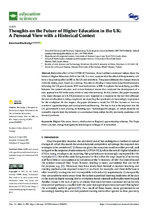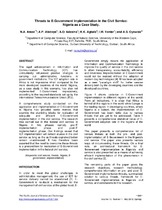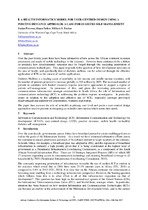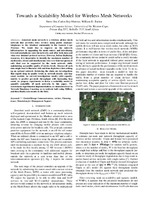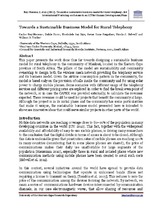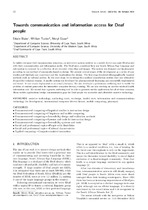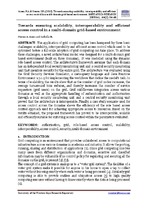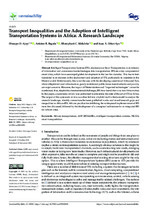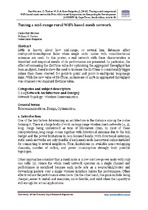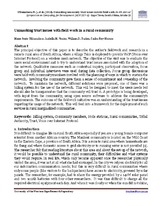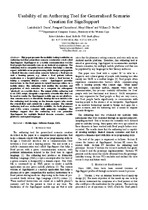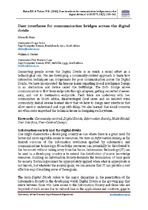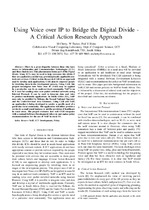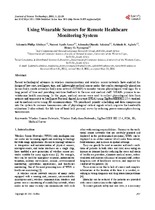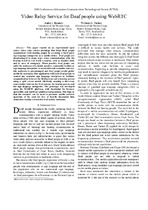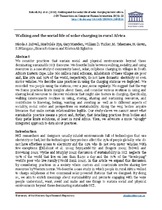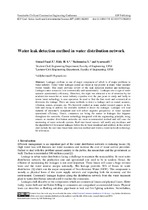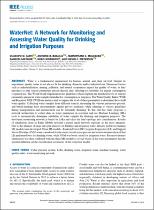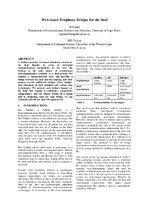Browsing Computer Science by Title
Now showing items 151-170 of 171
-
Thoughts on the future of higher education in the UK: A personal view with a historical context
(MPDI, 2021)Before the effect of the COVID-19 Pandemic, there had been continued debate about the future of Higher Education (HE) in the UK. It is now accepted that the effect of the pandemic will have a long-lasting effect on HE ... -
Threats to e-government implementation in the civil service: Nigeria as a case study
(Akamai University, 2012)The rapid advancement in Information and Communication Technology (ICT) has undoubtedly influenced positive changes in carrying out administrative functions in government institutions. The ICT adoption rate in Africa is ... -
Towards a model for user-centred design using a positive deviance approach: A case for diabetes self-management
(University of Cape Town, 2017)Over the past twenty years there have been substantive efforts across the African continent to ensure penetration and reach of mobile technology to the citizenry. However there continues to be a debate on precisely how ... -
Towards a scalability model for wireless mesh networks
(Telkom, 2015)Zenzeleni mesh network is a wireless ad-hoc mesh network that provides voice services using public analogue telephones to the Mankosi community in the Eastern Cape Province. We would like to improve on the network ... -
Towards a sustainable business model for rural telephony
(Telkom, 2012)This paper presents the work done thus far towards designing a sustainable business model for rural telephony in the community of Mankosi, located in the Eastern Cape province of South Africa. The pillars of the model are ... -
Towards communication and information access for deaf people
(SAICSIT, 2014)In tightly circumscribed communication situations, an interactive system resident on a mobile device can assist Deaf people with their communication and information needs. The Deaf users considered here use South African ... -
Towards ensuring scalability, interoperability and efficient access control in a multi-domain grid-based environment
(South African Institute of Electrical Engineers, 2013)The application of grid computing has been hampered by three basic challenges: scalability, interoperability and efficient access control which need to be optimized before a full-scale adoption of grid computing can take ... -
Transport inequalities and the adoption of intelligent transportation systems in Africa: A research landscape
(MDPI, 2021)Intelligent Transportation Systems (ITS), also known as Smart Transportation, is an infusion of information and communication technologies into transportation. ITS are a key component of smart cities, which have seen ... -
Tuning a mid-range rural WiFi-based mesh network
(ACM, 2013)Little is known about how mid-range, or several km, dis- tances a ect multipoint-to-multipoint links when single ra- dio nodes with omnidirectional antennas are used. In this poster, a real network with these characteristics ... -
UDCA: Energy optimization in wireless sensor networks using uniform distributed clustering algorithms
(Academic Journals Inc., 2011)Transceivers are the major energy consumption in a Wireless Sensor Network which is made of low-power, small in size, low cost and multi-functional nodes. These sensor nodes are operated by batteries which put significant ... -
Unmasking community trust issues in rural field work
(ACM, 2013)The principal objective of this paper is to describe the au thor's fieldwork and research in a remote rural area of South Africa, where a Village Telco is deployed to provide Voice over Internet Protocol on a wireless mesh ... -
Usability of an authoring tool for generalised scenario creation for signsupport
(Telkom, 2015)This paper presents the usability testing results for an authoring tool that generalises scenario creation for a tool called SignSupport. SignSupport is a mobile communication tool for Deaf people that currently runs ... -
User interfaces for communication bridges across the digital divide
(Springer-Verlag, 2006)Connecting people across the Digital Divide is as much a social effort as a technological one. We are developing a community-centred approach to learn how interaction techniques can compensate for poor communication across ... -
Using voice over IP to bridge the digital divide: a critical action research approach
(Telkom, 2003)There is a great disparity between those who have access to Information and Communication Technologies (ICTs) and those that do not. This phenomenon forms part of the Digital Divide. Many ICTs may be used to help overcome ... -
Using wearable sensors for remote healthcare monitoring system
(Scientific Research Publishing, 2011)Recent technological advances in wireless communications and wireless sensor networks have enabled the design of low-cost, intelligent, tiny, and lightweight medical sensor nodes that can be strategically placed on human ... -
Video Relay Service for Deaf people using WebRTC
(University of the Western Cape, 2019-03)This paper reports on an experimental open source video relay service prototype that helps Deaf people communicate with hearing people by accessing a third party sign language interpreter on a mobile device. Deaf people ... -
Walking and the social life of solar charging in rural Africa
(Association for Computing Machinery, 2013)We consider practices that sustain social and physical environments beyond those dominating sustainable HCI discourse. We describe links between walking, sociality, and using resources in a case study of community-based, ... -
Water distribution network leak detection management
(Curran Associates Inc., 2020)Water is becoming an increasingly scarce commodity and must be effectively managed to ensure minimal losses. Water is a basic human resource and during both a physical and a cyber war, limiting, or interrupting the supply ... -
Waternet: A network for monitoring and assessing water quality for drinking and irrigation purposes
(IEEE, 2022)Water is a fundamental requirement for human, animal, and plant survival. Despite its importance, quality water is not always fit for drinking, domestic and/or industrial use. Numerous factors such as industrialization, ... -
Web-based telephony bridges for the deaf
(Telkom, 2001)A Teldem provides text-based telephony services to the deaf. Despite an array of text-based communications mechanisms on the web, the Teldem is the only means of synchronous telecommunication available to a deaf person. ...

